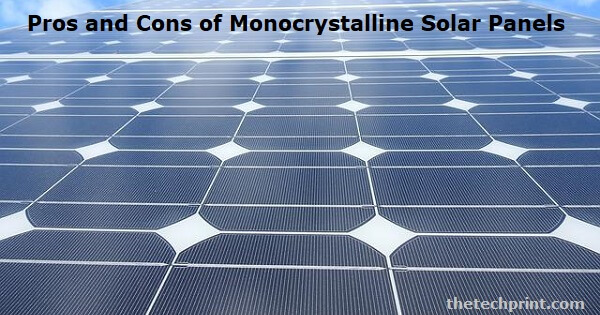Monocrystalline solar panels are made from a single large crystal of silicon. They are more efficient than other types of solar panels, and they have a long lifespan. Monocrystalline solar panels are also more expensive than other types of solar panels. They have only one flat color, and it appears to be uniform. They employ molten silicon to make one solid crystal and then cut it into silicon wafers, which are used to create solar cells. Though, much of the crystal is lost during production as waste. These pros and cons of monocrystalline solar panels will let you decide whether they are a good option than their counterparts (in terms of investment and efficiency).
These panels are made up of pure silicon and that’s what makes them more efficient than other types of solar panels. Here are a few pros of monocrystalline solar panels to note.
Due to their pure and dense silicon composition, monocrystalline solar panels have the highest efficiency rates compared to any other type of solar panel. The average efficiency rate for monocrystalline solar panels is 15-20%.
Monocrystalline solar panels also have the longest lifespan. With proper care and maintenance, they can last up to 40 years. These panels are made of tempered glass, making them more durable and resistant to harsh weather conditions. The warranty on monocrystalline solar panels is usually 25 years. Because both kinds of crystalline solar panels are composed of crystalline silicon, a very sturdy material, it's reasonable to expect that they will endure far longer than their 25-year guarantee period.
Even though monocrystalline solar panels are more expensive than other solar panels, they are becoming more affordable as technology improves and the demand for these solar panels increases.
Monocrystalline solar panels are ideal for hot climates because they have a higher tolerance to heat. They are also less likely to degrade in hot weather conditions, which will last longer. When the temperature rises, electricity production falls among all types of solar cells. Monocrystalline cells do not suffer as severely from degradation in output as polycrystalline panels.
Monocrystalline solar panels are also the most durable which is why they last longer. They can withstand extreme weather conditions and are not susceptible to hail or strong wind damage.
Monocrystalline solar panels are space-saving. They can be installed in smaller spaces because of their compact size. Such pros of monocrystalline solar panels are noteworthy when you have limited space.
Being made up of the oldest and purest material for solar panels, they have a few disadvantages.
The manufacturing of monocrystalline panels is incredibly high-quality; they are costlier than polycrystalline and thin-film solar panels. Consider the long-term cost and benefit of ownership when determining the price of these panels. A break-even evaluation may indicate that the expenditure is reasonable over a longer period.
Monocrystalline solar panels are also susceptible to shading. If even a small portion of the panel is shaded, it can significantly reduce the power output of the entire panel.
These also require more maintenance than other solar panels. They need to be cleaned more often to prevent dirt and dust from accumulating on the surface and causing the panel to become less efficient.
Finding pure Silicon for manufacturing solar panels is difficult. That’s why Monocrystalline solar panels are also limited in availability. They are not produced in as large quantities as other types of solar panels, so they can be more difficult to find.
Monocrystalline solar panels also require more space than other types of solar panels. These are composed of a single crystal, and as a result, they require more space than other types of solar panels. This is because the single crystal needs to be large enough to generate enough power. Additionally, monocrystalline solar panels are more efficient than other types of solar panels, so they require less space to generate the same amount of power.
Pros and cons of Monocrystalline solar panel conclusion
That question ultimately depends on a few factors, such as your location and how much sunlight you get throughout the year. If you can afford the upfront cost and are looking for maximum efficiency, monocrystalline solar panels may be right for you. However, polycrystalline solar panels could be a better option if you’re working with a tight budget or live in an area with less sun exposure. Ultimately, it’s important to do your own research and consult with a professional to determine which type of solar panel is best for your needs.

The most efficient form of the solar panel is monocrystalline, with efficiency rates typically in the 15-20% range. Because they produce more power for each square foot, these high-efficiency rates make them extremely space-efficient. Monocrystalline solar panels are generally more powerful and efficient when in warmer weather.
Monocrystalline solar cells are more efficient because they are cut from a single piece of silicon. Polycrystalline solar cells are made from many different silicon fragments and have a slightly lower efficiency rating. Thin-film technology is less expensive than mono or poly panels and less effective.
Compared to different solar panel varieties, monocrystalline panels have the greatest efficiency. They take up the least amount of space among all comparable products. Monocrystalline solar panels have a longer life expectancy and are more likely to operate beyond their guarantee period.
The average cost of monocrystalline solar panels is $1 to $1.50 per watt. Thus, a 6KW system costs between $6,000 and $9,000.